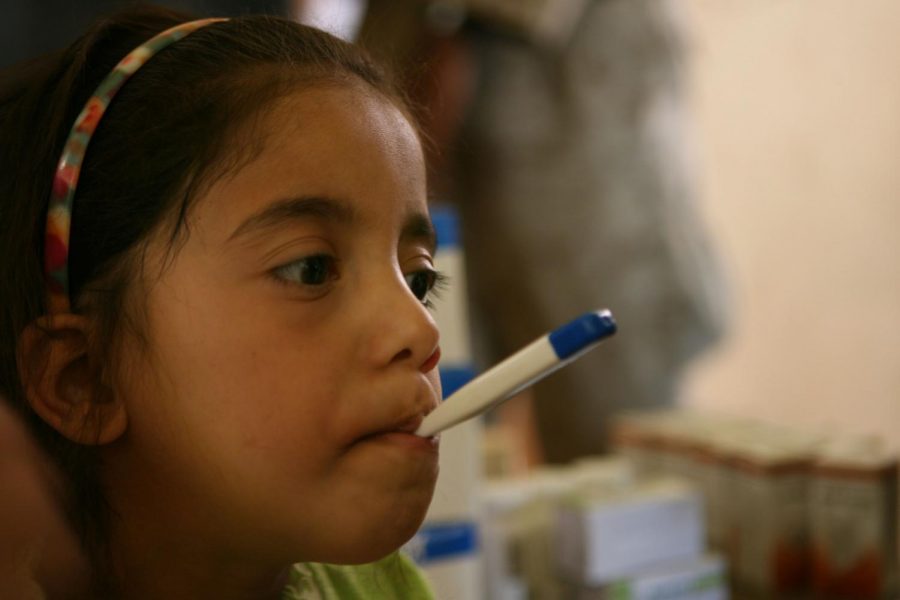California experiences stronger flu season than usual
February 23, 2018
This year’s flu season has proven significantly stronger than usual statewide, causing greater hospitalization rates and tolls on the community, but has not seen as adverse of an outcome in Harker campuses.
Cases of statewide illnesses shot up in November, and as of Jan. 26, 97 deaths of people under age 65 have been reported in California by the California Department of Public Health. Influxes of patients in hospitals are putting higher demand on medical facilities, with some centers seeing shortages in medication and other resources, and according to the Center for Disease Control (CDC), the season possibly still hasn’t hit its peak yet.
For the upper school, the effects of this flu season do not seem much worse than those of previous flu seasons. According to head nurse Debra Nott, one to four students are being sent home due to the flu per day across kindergarten to grade 12, which is a mild statistic compared to averages of ten to twelve students being sent home in some of the strongest seasons in previous years.
“I have seen two major flu seasons at Harker, which came to the point where we were looking at options of closing the school for a day or two,” Nott said. “We are nowhere near that this year.”
Nonetheless, the flu has struck with more intensity, lasting longer than normal and with more severe symptoms. A primary cause of the heightened flu activity is one of this year’s active strains, the influenza A H3N2, a dangerous strain normally originating in pigs that is able to mutate frequently, affect senior citizens with particular severity and often the vaccination.
“[H3N2] is one of the strains that is in the immunization against the flu, but H3N2 is an aggressive mutator,” Nott said. “With this particular strain this year, the severity is a little worse, and how I base that is how many days of fever I see. We’re seeing the fever last five or even seven days, which is a very long time to be that sick.”
Michelle Si (9), a student who contracted the flu, did experience higher fever levels but noticed that otherwise, symptoms were manageable.
“I think this year’s fevers were higher, but general well-being during the fever was not that bad,” Michelle said. “If I didn’t know that my fever was at 102, I wouldn’t have guessed I was very sick. It felt more like a mild cold besides the tiredness.”
Freshman Jason Kwok experienced a different set of symptoms including lightheadedness and body ache when he had the flu and was contagious for four days, during which he remained at home.
“It started as [feeling] really really light headed. After that, I just got a really bad fever, and I felt really weak and dizzy,” Jason said. “I was sleeping most of the time, and when I wasn’t sleeping, I was drinking medicine and eating.”
As a reminder from the nurse’s office, the best prevention, even now, is to get the flu vaccines, which requires about two weeks’ time to incubate according to the CDC, and washing hands regularly and keeping them away from the face help as well.
Students with fevers above 100 degrees Fahrenheit need to go home and stay home until at least 24 hours after the fever has passed, and those with the flu should immediately seek medical attention and contact their doctors or hospitals for the appropriate medication and treatment.


















![“[Building nerf blasters] became this outlet of creativity for me that hasn't been matched by anything else. The process [of] making a build complete to your desire is such a painstakingly difficult process, but I've had to learn from [the skills needed from] soldering to proper painting. There's so many different options for everything, if you think about it, it exists. The best part is [that] if it doesn't exist, you can build it yourself," Ishaan Parate said.](https://harkeraquila.com/wp-content/uploads/2022/08/DSC_8149-900x604.jpg)




![“When I came into high school, I was ready to be a follower. But DECA was a game changer for me. It helped me overcome my fear of public speaking, and it's played such a major role in who I've become today. To be able to successfully lead a chapter of 150 students, an officer team and be one of the upperclassmen I once really admired is something I'm [really] proud of,” Anvitha Tummala ('21) said.](https://harkeraquila.com/wp-content/uploads/2021/07/Screen-Shot-2021-07-25-at-9.50.05-AM-900x594.png)







![“I think getting up in the morning and having a sense of purpose [is exciting]. I think without a certain amount of drive, life is kind of obsolete and mundane, and I think having that every single day is what makes each day unique and kind of makes life exciting,” Neymika Jain (12) said.](https://harkeraquila.com/wp-content/uploads/2017/06/Screen-Shot-2017-06-03-at-4.54.16-PM.png)








![“My slogan is ‘slow feet, don’t eat, and I’m hungry.’ You need to run fast to get where you are–you aren't going to get those championships if you aren't fast,” Angel Cervantes (12) said. “I want to do well in school on my tests and in track and win championships for my team. I live by that, [and] I can do that anywhere: in the classroom or on the field.”](https://harkeraquila.com/wp-content/uploads/2018/06/DSC5146-900x601.jpg)
![“[Volleyball has] taught me how to fall correctly, and another thing it taught is that you don’t have to be the best at something to be good at it. If you just hit the ball in a smart way, then it still scores points and you’re good at it. You could be a background player and still make a much bigger impact on the team than you would think,” Anya Gert (’20) said.](https://harkeraquila.com/wp-content/uploads/2020/06/AnnaGert_JinTuan_HoHPhotoEdited-600x900.jpeg)

![“I'm not nearly there yet, but [my confidence has] definitely been getting better since I was pretty shy and timid coming into Harker my freshman year. I know that there's a lot of people that are really confident in what they do, and I really admire them. Everyone's so driven and that has really pushed me to kind of try to find my own place in high school and be more confident,” Alyssa Huang (’20) said.](https://harkeraquila.com/wp-content/uploads/2020/06/AlyssaHuang_EmilyChen_HoHPhoto-900x749.jpeg)







